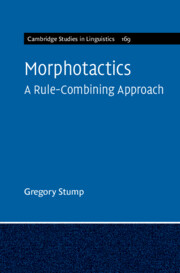Book contents
- Morphotactics
- Cambridge Studies in Linguistics
- Morphotactics
- Copyright page
- Dedication
- Contents
- Figures
- Tables
- Preface and Acknowledgments
- Abbreviations
- Symbols and Operators
- 1 Canonical Morphotactics
- 2 Rule Combinations
- 3 Dependent Rules and Carrier Rules
- 4 Rule Composition and Rule Ordering
- 5 Extending Canonical Morphotactic Criteria to Composite Rules
- 6 Rule Combinations Expressing Holistic Content
- 7 Rule Aggregation
- 8 Complex Morphotactic Interactions in Swahili
- 9 The Nonassociativity of Rule Composition in Murrinhpatha
- 10 Potentiation and Counterpotentiation
- 11 Rule Combinations and Morphological Simplicity
- 12 Rule‑combining Morphotactics and Morphological Theories
- 13 Conclusions
- References
- Index
4 - Rule Composition and Rule Ordering
Published online by Cambridge University Press: 24 November 2022
- Morphotactics
- Cambridge Studies in Linguistics
- Morphotactics
- Copyright page
- Dedication
- Contents
- Figures
- Tables
- Preface and Acknowledgments
- Abbreviations
- Symbols and Operators
- 1 Canonical Morphotactics
- 2 Rule Combinations
- 3 Dependent Rules and Carrier Rules
- 4 Rule Composition and Rule Ordering
- 5 Extending Canonical Morphotactic Criteria to Composite Rules
- 6 Rule Combinations Expressing Holistic Content
- 7 Rule Aggregation
- 8 Complex Morphotactic Interactions in Swahili
- 9 The Nonassociativity of Rule Composition in Murrinhpatha
- 10 Potentiation and Counterpotentiation
- 11 Rule Combinations and Morphological Simplicity
- 12 Rule‑combining Morphotactics and Morphological Theories
- 13 Conclusions
- References
- Index
Summary
I discuss different kinds of deviation from the parallel sequence criterion; I illustrate with detailed examples from Fula, Udmurt, and Eastern Mari. In Fula verb inflection, rules of subject and object marking involve a default applicational sequence that is overridden in specific circumstances by the opposite sequence of application; this deviation can by modeled by postulating two patterns of rule composition, one realizing the default sequence and the other overriding that default. Udmurt noun inflection is different, since it involves two patterns of rule composition that do not stand in a default/override relation but are instead simply complementary. Nevertheless, the Fula evidence and the Udmurt evidence both conform to the unique sequence criterion. The declensional morphology of Eastern Mari, by contrast, deviates from that criterion, since it allows alternative acceptable sequences of rule application; in the rule-combining approach to morphotactics, these can be seen as involving alternative patterns of rule composition realizing the same morphosyntactic content.
Keywords
Information
- Type
- Chapter
- Information
- MorphotacticsA Rule-Combining Approach, pp. 113 - 140Publisher: Cambridge University PressPrint publication year: 2022
